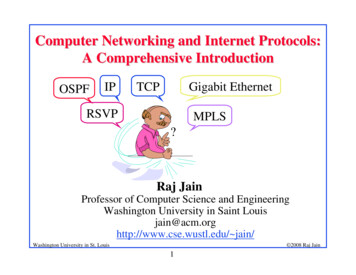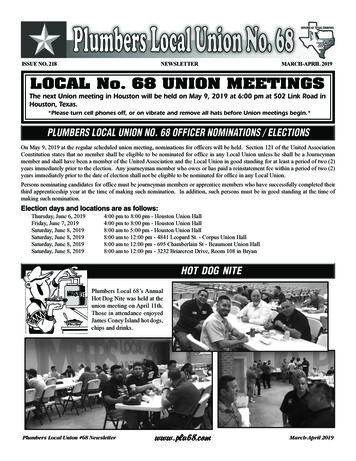
Transcription
JANUARY 2013 VOLUME 4 ISSUE 1 1INSIDEJustice system reform – p. 2Sense of direction – p. 3LocalLoaves– p. 7Feed the right wolf – p. 3Aimee’s empathy– p. 4Election reflection– p. 4Art therapy at PORT – p. 5Book review– p. 6Standards & housing– p. 6Puzzles– p. 8Revelations in lyrics – p. 10Deaths of the homeless – p. 11www.GroundcoverNews.comYourPle donas atioeb nuy diron ec tly lyf ro b em neba fitsdg thed e vve e nnd doo r r s.s
OPINIONPervasive justice system shortcomings shame MichiganRELIGION2by Susan BeckettPublisherI’d like to wish you all a happy NewYear and write a column about all thewonderful adventures in store for us,but there are so many shortcomingsin the Michigan justice system thatdemand immediate attention that Imust address them right now while thelegislature is working on reform. Thelegislature is working on adjustmentsthat will result in lighter caseloads forpublic defenders, which theoreticallywill afford better representation forindigent clients. Dysfunctional courtclerks and computers, abusive bondingprocedures, incentives for keepingpeople in the system, and a general lackof information about the jail and courtprocedures also need addressing.GROUNDCOVERMISSION:Groundcover Newsexists to create opportunityand a voice for low-incomepeople while taking actionto end homelessness andpoverty.Susan Beckett, Publishercontact@groundcovernews.comLee Alexander, Editorc.lee@groundcovernews.comAndrew Nixon, Associate EditorContributorsStacey BalterMartha BrunellPeggy DonhamLeonore GersteinGreg HoffmanDanielle MackRobert SaloMartin StolzenbergLetters to the Editor:editor@groundcovernews.comStory or Photo s.comfacebook.com/groundcover423 S. 4th Ave, Ann Arbor734-972-0926What the professionals sayJudge Tom Boyd, representing theMichigan District Judges Association(MDJA), says the MDJA supports thereform bill, HB 5804, and that “changeis necessary.” He said that throwingmoney at the problem was not thesolution, and that looking at variousmetrics, as the bill suggests, would leadin the right direction. He also pointedto the fact that many cases do not goto trial and that the system needs moresafeguards than are currently in place inorder to ensure the fairest outcome forthose involved.This position was countered by RobertDaddow, deputy Oakland Countyexecutive, who said the Countysupports the need for improvementsin the system but not the bill itself.“Quality standards need to be placedat the front end of the process, not theback end,” Mr. Daddow said.Rep. Tom McMillin, R-Rochester Hills,got to the heart of the matter whenhe said, “When it comes to budgetseason at the counties, you’ve got theelected sheriff, you’ve got the electedprosecutor – you’ve got people fightingfor their budget. There’s nobodyfighting there for the indigent defense.“It’s a big deal. I think that we needto make sure it’s being done right, asmuch as we can, in this state. We needto understand how this is going andwhat standards should be met to makesure that their system isn’t locking awaypeople who shouldn’t be locked away,and charging us 35-grand a year to doit.”First-hand experienceLike most of you, I had no personalexperience with courts, publicdefenders or bail bondsmen until lastsummer when one of our vendors wasarrested in Belleville, part of WayneCounty. She was accused of attackingsomeone. Her story was that he triedto violate her and she defended herself.She got no counseling or medicalattention but was dragged into courtwhere her public defender pushedher to accept a plea bargain that shethought meant she could leave rightaway and get back to her baby. Whenshe later understood that was not thecase, she was very distraught and askedto withdraw the plea.Thanks to some generous Groundcoverreaders, I undertook getting herreleased on bail. That set me on atwo-month odyssey during whichmy middle class expectations ofconvenience, transparency and fairnesswere shattered.I looked into posting bail, which wasset at 10 percent of 10,000. The bailbondsman would post bail for a fee of 330, if that was accompanied by anagreement of liability for the wholebond from two full-time workingadults and the rights to a fully-ownedautomobile, should the bail conditionsbe violated. They also demanded thatsomeone be with them when theyposted bail to accept custody of theperson upon their release.This seemed absurd. We were stilltaking all the risk and inconvenience,and paying them a lot of moneyjust for fronting two-thirds of thecost. I tried to learn more about theprocess of posting bail, but foundnone of my lawyer friends or any ofthe public defenders or prosecutorsI called could explain the risks andprocess in more than vague terms, norwas the information on the WayneCounty website. I did learn that if ourvendor did not show up for any courtproceeding or court-ordered procedure,the bail money would be in jeopardy.I also learned from the prison guardsthat there was no way to post bailelectronically. You could use a creditcard, but only on-site, and througha government approved third-partycompany that charges a hefty fee, on theorder of 25 percent, which is disclosedin its entirety only once the transactionis in process. It rapidly became apparentthat the “prison-industrial complex,”as one of my lawyer friends refers to it,has little regard for the lives of thoseenmeshed in its system.I learned from the guards at the jailthat our vendor would not be releasedwhen bail was posted, since the courthad ordered a tether and the tetherdepartment worked at their own paceduring limited hours. They also toldme I’d need to give them the name andphone number of the person she’d bestaying with when she was released,and that she would be responsible forthe 100 tethering setup fee and anadditional 12-29 per day. Tetheringhas become commonplace even forthose who are not flight risks and arealready homeless.Another volunteer and I went to thejail, toting our ten 100 bills andaddress book. The guard expressedsome surprise that we were posting bailourselves, then told us that she had torun our vendor’s name for outstandingwarrants. Unfortunately, one turnedup for failing to appear at a hearing inWashtenaw County that occurred whileshe was incarcerated in the WayneCounty Jail and of which she had noknowledge. The guard explained thatif we were to bond her out, instead ofher being released after tethering, shewould be transferred to WashtenawCounty. If they kept her and she missedwww.groundcovernews.comany of the Wayne County-orderedappearances, we stood to lose thebail money. As we knew there was anevaluation that had to take place, we leftwithout posting bail. There was no wayfor us to get a message to our vendoror to see her and explain the situationand get more details on the outstandingwarrant.I called and emailed the Wayne Countycourt-appointed attorney for help inresolving the warrant and to get a firmdate for the evaluation, but got noresponse from him and learned on asubsequent visit that he did not contacthis client about it, either. The day beforethe next hearing date, I learned that ajudge’s convention conflicted with thehearing date and since the evaluationhad still not been done, the hearing waspostponed for another month. WhenI pressed the lawyer on the evaluationhold-up, he said that he had checked onit and the records indicated that theyhad already done it, but actually hadnot.Even though there was no hearing, Idrove into Detroit as planned to postbail, convinced this was the only wayshe would ever get the evaluation andan opportunity for an adequate defense.As it was during court hours, I had topost bail at the courthouse. When Itried to do so, they told me that it wasno longer 10 percent of 10,000, butthe entire 10,000. Sure that it was amistake, I asked them to check. Theytried, but only the judge, who was atthe conference, and her clerk couldgive a definitive answer. By now itwas 12:15 p.m., and the clerk was notanswering her phone; they told me shehad stepped out for a few minutes. At12:30, I asked them to check again andfind out if she had gone to lunch. Theydid and said they thought so, so I leftfor lunch, too. Back at 1:00, I askedthem to check again. At 1:20, I sawa group of employees returning andasked them to check again. Finally, at1:30, I got permission go to the clerk’swork area and ask around myself. Allthe doors were locked but someonedid answer when I knocked on theAdministration door. She informedme that the courts closed betweennoon and two for lunch and that theclerk would return at two. I asked herto verify that since the judge was goneand perhaps the clerk took that Fridayafternoon off. She assured me the clerkwould return.At 2:15, an employee in the Drug Courtnoticed me, asked how I was, anddecided to help me in response to mydeclaration of frustration. He calledthe judge’s secretary, who eventuallyemerged with a piece of paper detailingthe various hearings that had takensee WAYNE COUNTY, page 9A sense of directionby Rev. Dr.Martha BrunellPastor, BethlehemUnited Church ofChristI have a long-established pattern withcars. I buy small, manual transmissionvehicles that are easy to park andeconomical on gas. And then withregular maintenance, I drive them asclose to 300,000 miles as I can get.My ministry and personal life havelong had their share of driving, so Icover that mileage in about a decade.I have just retired a car from the roadat 262,402 miles. I would have drivenit another year or so, but I am ready tohave all-wheel drive underneath me,especially with another winter upon us.These days a lot happens to cardesign in a decade. In my still small,economical, easy-to-park, manualtransmission car that now has all-wheeldrive, I no longer have windows thatI can roll up and down by myself. Iam enjoying the ability to adjust myside-view mirrors from inside the car,and the fact that the rear-view mirrorchanges its surface automaticallyas light gives way to dark is muchappreciated. I wasn’t sure that heatedseats were necessary, but I am gettingused to them, too. However, the newfeature in this car that I most enjoy isthe compass embedded in the rear-viewmirror. I have a good sense of compassdirection, but am fascinated withkeeping track of the flow of the roadbeneath me that is as often SW or NE asit is true S or N.Attending to the compass in my rear-3view mirror has made me pondermore often the subject of our internalcompasses. What are the directions wepursue and why? What directions arepreferred ones for us as we orient orreorient our lives? When I give thoughtto directions for my life based on myinvolvement with Groundcover News,this is how I would name the directionsI want to return to when I feel lost ordisoriented: Do I appreciate and affirm thevaried gifts that each one brings tothe table? Will I name difficult subjects wetend to avoid as a culture? Have I told others the story ofwhat we are up to together atGroundcover News? Will I keep at this effort or similarefforts over the long haul? Am I seeking the common goodin a specific way or ways I canidentify? Am I articulating what is importantto me? Do I know a wide assortment ofpeople?As we begin a new calendar year, Iam more and more aware of the graceand the goodness we share as thecommunity of Groundcover News. Youare a part of decent and substantialdirection in my life. On that sense ofdirection I rely. And so to you all I say,“Thank you!” How do I draw strength and energyfrom those who are working on anissue with me?What we can do about mass shootingsby Susan BeckettNatural calamities like hurricanesand earthquakes batter our bodies;man-made catastrophes like the massshooting in Newtown’s Sandy HookElementary School and genocidalwars batter our souls. We feel theconnectedness of mankind and writhein the discomfort of our powerlessness.In her book Taking the Leap, Buddhistsage Pema Chodron shares this storyand a reflection on how we can impactour world:There was a story that was widelycirculated a few days after the attacksof September 11, 2001, that illustratesour dilemma. A Native Americangrandfather was speaking to hisgrandson about violence and crueltyin the world and how it comes about.He said it was as if two wolves werefighting in his heart. One wolf wasvengeful and angry, and the other wolfwas understanding and kind. The youngman asked his grandfather which wolfwould win the fight in his heart. Andthe grandfather answered, “The one thatwins will be the one I choose to feed.”So this is our challenge, the challenge forour spiritual practice and the challengefor the world: how can we train rightnow, not later, in feeding the rightwolf? How can we call on our innateintelligence to see what helps and whathurts, what escalates aggression andwhat uncovers our good-heartedness?With the global economy in chaos andthe environment of the planet at risk,with war raging and suffering escalating,it is time for each of us in our own livesto take the leap and do whatever we canto help turn things around. Even theslightest gesture toward feeding the rightwolf will help. Now more than ever, weare all in this together.Bethlehem United Church of Christ423 S. Fourth Avenue, Ann Arbor, MI 48104(between William and Packard)www.bethlehem-ucc.org (734) 665-6149Bethlehem Church is home for the Groundcover OfficeSundays:Thank you for feeding the rightwolf when you bought this issue ofGroundcover and took the time to readit.8:30 am and 10:00 am Worship10:00 am Church SchoolSWAMI’S DICTIONARYUpcoming Events:January 1 Office & building closed.January 25 Parking Lot PretzelsNonjudgment DaySale starts at noonA time when enough humans stop criticizingone another, that we achieve uncritical mass.A day when everyone wins beauty contests,and all lawyers disappear because our trialsare over. See Disarmageddon.-- Swami BeyondanandaJanuary 27 Chamber Music Concert 3:00 pmFebruary 1 Sauerkraut SupperOpen to the publicTickets: 12 for adults / 5 for children 10 and underan invitation to grow in spirit and serve with joywww.groundcovernews.com
ON MY CORNERA day with Aimee Ciccarelli, superwoman4by Stacey BalterGroundcover ContributorEarly in November, I chose to spend aday shadowing a Groundcover vendor.The first thing that struck me aboutAimee Ciccarelli was not the fuzzypurple socks, purple scarf, purplecoffee mug, and purple eye shadow shewears, but the warmth and authenticityof her smile.Aimee lived at the Delonis Centerfor three months before she wastold to find housing elsewhere andconsequently took up residence withher son. She is recuperating fromknee surgery, but is still on the streetsselling Groundcover with a seeminglyendless abundance of energy. Aimeehas been selling Groundcover sinceSeptember, and has quickly become asuper saleswoman, through her charmand charisma. “I try to compliment atleast 50 people a day,” Aimee discloses,“in case someone is having a bad day.I figure hearing something nice willmake them feel better.”When Aimee isn’t being a supersaleswoman, she’s being a super friend.Aimee has been taking care of awoman she met at the Delonis Center,who is an amputee, and when sheneeded care, Aimee volunteered.Not only does she treat her friendswith kindness, Aimee brings thatsame respectto strangerson the street.She greetsevery personwalking bywith a cheerfulcomplimentand sales pitch.Oftentimes,people engagein conversationwith her, drawnin by her smileand cheer.she made someone’s day a little brighter.She has resolved to be a better friendto people going through a hard time,transforming the negativity from thepast into a new cause for the future.Bad things needn’t be dragged alonglike heavy baggage, because accordingto Aimee, it’s “water off a duck’s back,turn the other cheek, and a kind wordcan turn away wrath.”While she hasfaced muchturbulencein the past,Aimee drawsback fromher negativeemotions andturns theminto somethingpositive.Hanging fromher purpleFor Aimee, selling Groundcover is also a way to brighten the liveswalker are three of others.bags filled withAfter the suicide of her cousin, Chasestuffed animals, which she donates toEdwards, her aunt and uncle lobbiedyoung children in remembrance of herto get depression awareness taughtson Jayden, who died of a heart defect.in schools. Aimee tries to spreadAlthough she has witnessed her fairawareness in her own way, even goingshare of hardships, Aimee jokes, “I likeout of her way to compliment peopleto say my blood type is ‘B positive.’”who have no apparent interest inbuying the paper, just so she can knowElection reflection: a humorous look at why Romney lostby Martin StolzenbergGroundcover ContributorPart 1 of a three-part series—Start-UpTimeNow that some time has passed, it isappropriate to look back on the 2012presidential campaign and gain someclarity on what occurred. So muchhappened, and often so quickly; asevents unfolded it seemed like a blur— all “smushed” together. Now we canassemble this giant jig-saw puzzle, andsee what it reveals.President Obama rode easily into officein 2008, promising “change.” By 2012,many thought his uninspiring firstterm wasn’t exactly the “change” theyhad in mind.Going into the new campaign,Governor Romney had a lot going forhim. He looks like someone sent fromcentral casting to play the president.The guy with the ears that stick outlooks like Alfred E. Neuman on thecover of Mad Magazine.To top it off, Governor Romney wasgetting a boost from hundreds ofmillions of dollars pouring into hiscampaign from billionaire PAC politicaldonations. This was a present from theconservative Supreme Court, whichhad just ruled that every dollar votes,not people.As the campaign unfolded, thepolitical analysts and talking headskept babbling about what a close raceit was. With all he had going for him,Governor Romney should have sweptthe Electoral College and won by 10percentage points in the popular vote –instead of losing them both.Roemer, Paul Ryan and Rick Santorum.John Huntsman, Jr., a moderate, didn’tfit in the clown car – so his campaignquickly foundered.Throughout the twenty primary debates– that is right, twenty – the candidatesplayed the clown game: Who can be themost conservative? Governor Romneyjoined right in, even though he wasknown to be a moderate Republican.How did this occur?It starts with the primaries. Indeed,Governor Romney was the bestcandidate from a Republican field thatlooked like a bunch of circus clownscoming out of a little old Volkswagenbug. Climbing out of the car there wasMichelle Bachmann, Herman Cain,Newt Gingrich, Gus Johnson, RonPaul, Tim Pawlenty, Rick Perry, Buddywww.groundcovernews.comAimee’s genuine smile doesn’t showthe stings of people who passed her by,ignoring her completely, or occasionallythrew a rude comment our way. This isbecause for every person who ignoredher, another dozen stopped and chatted.We met a family who run a DonkeyRescue carrying a wooden stand witha toy donkey head on it out of theKiwanis Center. We met a couple withtwo young children who immediatelyjumped on the free stuffed animalsAimee gives out.“I love my job,” Aimee tells me, andalthough being a vendor comes withits abundant challenges, I can see whyshe does; we became a fond memoryfor every person who stopped by totalk, for every child carrying a newstuffed animal. By the end of the day, Iwas exhausted – and I’m not even theone recuperating from knee surgery!– but I was also heartened by all theencounters I’ve had, and the communaljoy shared between Groundcover andthe community.All the clowns vowed they wouldn’tvote for curtailed spending that wouldclose 90 percent of the deficit, coupledwith a modest 10 percent coming fromincreased taxes, including GovernorRomney.They probably wouldn’t have votedfor a tax bill that cut governmentAGENCY SPOTLIGHTArt therapy engages PORT clients5by Greg Hoffman and Robert SaloGroundcover Intern and VendorThe Project Outreach Team (PORT)engages with people in creative ways,and now they are tapping clients’creativity to help them move pastsome of the difficulties in their lives.PORT is a community mental healthagency that works with the homeless,addicted and mentally ill people inWashtenaw County. They have beenwidely acknowledged for their soccerteam, SSPORT.At a retreat earlier in the summer,the staff recognized a need for morecreative opportunities for clientengagement that also providedtherapeutic support. They gatheredfeedback from clients to get an ideaof what types of engagement peoplewould find exciting.“I personally love to do arts and crafts,”commented Robert Salo, a participantin the new program. “I find it verycalming and peaceful so I thoughtothers might think so, too.”Jessica Lusk, one of the three mentalhealth nurses at PORT, was particularlyinterested in implementing an arttherapy program because she hadtaken several art classes in the past andpersonally attests to the therapeuticeffect that artistic expression canprovide.“I think it’s a creative way for peopleto express themselves and developinterpersonal skills,” said Lusk. “It is anon-verbal way to express their feelingsand emotions.”Lusk said that art is a great way forclients to express themselves, especiallyindividuals who have experiencedsignificant trauma in their lives andare coping with Post Traumatic StressDisorder (PTSD). Using art as amedium, these individuals have anoutlet to display what they often haveCheerful artists show off the jewelry they made in PORT’s new art therapy program.difficulty articulating in words.Lusk coordinates the art therapyprogram, which is held on Mondaysfrom 1-2 p.m.The program is still relatively new,and has not gained a lot of popularityyet, but there is a core group ofattendees each week. Lusk also worksalongside the PORT psychiatriststo provide mental health services toPORT’s clients, including assistancewith obtaining medications andcoordinating with insurance providersto procure other medical and mentalhealth services for clients.People can participate in the arttherapy program even if they are notPORT clients. PORT is located at 110N. Fourth Avenue in downtown AnnArbor.“Nurse Jessica is looking forward toseeing you there,” quipped Salo.PORT is lookingfor donations ofart supplies to helpdevelop the programand to make itmore inclusive fornew participants.Particularly, there is aneed for acrylic paintsand paint brushes.PORT is also lookingfor individuals whowould be able tovolunteer their timeassisting with the arttherapy program,especially if they haveany experience teachingart. If you would liketo contribute either artsupplies or your timeas a volunteer, pleasecontact Jessica Luskat (734) 323-5803, oremail her at luskj@ewashtenaw.org.see MITT, page 12JOIN HEREIT’S GOOD FORTHE HEARTANN ARBOR YMCA400 West Washington StreetAnn Arbor, Michigan 48103www.annarborymca.orgAt the Y, we exist to strengthen community.Together with people like you, we nurture thepotential of kids, help people improve their health,and provide opportunities to support our neighbors.So join our cause. And create meaningful change notjust for your family, but also for your community.Expires 1/31/2013Not good with any other couponwww.groundcovernews.com
6Book Review: Magical HorsesTHE AR TSby Cleopatra Egyptc. 2005 by NanoartHDReview by Susan BeckettDear Editor,It needs to be easier to be poor in America. Laws are continually writtento make housing and transportation better, of higher quality and safer.These laws also make housing and transportation more expensive because there is an inextricable correlation between high quality and highcost. There are arbitrary regulations in the name of quality that makehousing extra expensive. There are excessively liability-conscious regulations in the name of safety that make occupancy prohibited.(Ms. Egypt’sautobiography is below)Set in the realm of theHaitian spirits, thiscautionary tale providessome insight into thetraditional culture andbeliefs of the island.It includes a detaileddescription of the eightprinciples of Vodou(Voodoo), each of whichhas an associated color,physical representationand special talent.The story centers aroundAzaka, the Spirit ofthe fields, who is anarrogant and greedyfarmer who neglects toexpress gratitude for theabundance in his life. Hetakes advantage of othersand is rude to them. Hishorses, the Spirits of love and war,observe him learning to perform avévé ritual to honor Legba. When heneglects both the vévé and the horsesthe following morning, they make thevévé themselves and are transformedinto human forms.Azaka is frantic to get his horses backbut spurns the offer of Gran Bwa, theSpirit of the forest who offers him thegifts of clarity and intuition in exchangefor a daily offering. Though the Spiritof motherhood tells him, “The moreyou share, the more you’ll receive” andMore housing through lower standardsI am a small-potatoes landlord. I own a couple of rental properties. Ibelieve in building inspections. Over the years, I have grown in my appreciation for Building Inspectors. I have learned a great deal from thedozens of building and trade inspections I have paid for. I am very carefulabout maintaining my properties and keeping my Certificates of Occupancy current.the Spirit of love does all she can tohelp him change for the better, Azakacannot shed his mean-spirited waysand pays the price in the end.Certificates of Occupancy should be gradients and available for examination by prospective tenants. If a building does not have a Certificate ofOccupancy, then the owner should be required to apprise prospectivetenants of the limitations and unfulfilled requirements, but not prohibited from offering it for rent. Tenants may or may not want to live in abuilding that does not have a Certificate of Occupancy, but if they are oldenough to sign a lease, then they are adults. Without a Certificate of Occupancy, owners of such buildings would be forced by market conditionsto charge less rent. Prospective tenants, who would live there at theirown risk, would expect to pay less rent. A partial political solution tohomelessness – cheaper, legal housing – would be to legislate gradationsof occupancy instead of on/off, black/white, certified or illegal currentconditions.Matthew GutchessThe writing style is simple and inplaces the moralizing is transparentto the detriment of the action of thestory. The actions of the Spirits havesome complexity and bear discussionand examination. Magical Horses isa very quick read that might serve asan introduction to Haitian religionand culture, especially for middleschool students.FeSaI tNuEreS SBUA local food community that is healthy for youby Leonore Gerstein, GroundcoverContributor and Robert Salo,Groundcover VendorHave you ever wondered if groceryshopping could be a task you actuallydo just for the fun of it? Just as anexperiment, go to the Ypsilanti FoodCo-op (YFC). We are pretty sure youwill discover that your experience waspleasant beyond all expectations.Located in Depot Town, it is housedin the vintage Mill Works Buildingon spacious, tree-lined River Street.Nowadays, just before Christmas, thebare shade trees in front of the storeare complemented by an array offragrant seasonal fir trees and wreaths,arranged by co-op staffers Robert andJordan. Inside, at any time of the year,the lighting is cheerful but not toobright, the atmosphere cozy, and thesmall-scale dimensions immediatelyinviting. Staff people greet you warmly,as does the smell of freshly-madesoup (available, along with coffee, fora modest price). All that is missingto make this an old-fashioned villagehang-out is a pot-bellied stove.Elisabeth Daumer, who has been amember for 23 years, confirmed ourfirst impressions, stating that what shelikes especially about the co-op is thehomey, welcoming atmosphere andthe array of foods that are delicious aswell as healthy. Those of you who areecology-minded will admire the YFCfor generating all of its own electricpower from 30 photo voltaic (solar)panels on the roof.I was born in Port-au-Prince, Haiti in1961 by the name of Antoine MarieJasmin. Prior to coming to America inNovember 1971 with my family, mystepfather adopted me and I took on hislast name, Prepetit. I graduated fromSt. John’s University with a bachelor’sdegree in French Literature in Januaryof 1986. Seven years later, I changed myname to Cleopatra Egypt for spiritualand cultural reasons.After some poor financial choicesand making the mistake of includingmy Brooklyn co-op apartment inmy Chapter 7 bankruptcy in 1994, Iwas evicted. I started on a four-yearhomeless moving spree that took meto Santa Monica, California, Martha’sVineyard, Massachusetts, Sedona,Arizona, back to Santa Monica, thenCambridge, Massachusetts, and finally,back to New York.A co-op is a nonprofit organizationowned entirely by its member owners.The YFC is governed by a sevenmember democratically elected boardof directors, with the help of severalcommittees. The board is responsible tothe members for upholding the visionof the organization. Membership, alsocalled a “fair share investment,” costs 200, payable over 10 years. Memberowners enjoy the co-op’s profits inthe form of a discount at the registerrather than a year’s-end distribution,explained manager Corinne Sikorski.Membership is not required andeveryone is warmly welcomed to shopat the co-op.The road to writing Magical Horses in2005 was a difficult one. Trauma fromphysical and emotional abuse at thehands of my mother throughout mychildhood and into adulthood made itvery difficult for me to stay employed,and I earned very little as I dealt withthe pressures of life and being a singlemother.Thanks to the New York City HousingAuthority, I was able to get a placeof my own again in 2002. The rent isnot high and it’s based on my income.Having that sense of stability, I wasable to write again. With the help of aclose friend, I self-published a folktale –Magical Horses – that reflect
Jan 10, 2013 · In her book Taking the Leap, Buddhist sage Pema Chodron shares this story and a reflection on how we can impact our world: There was a story that was widely circulated a few days after the attacks of September 11, 2001, that illustrates our dilemma. A Native American grandfathe










